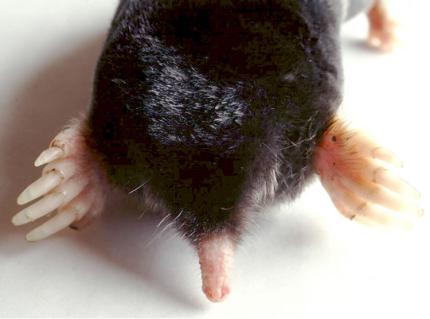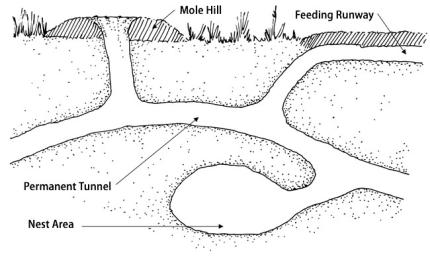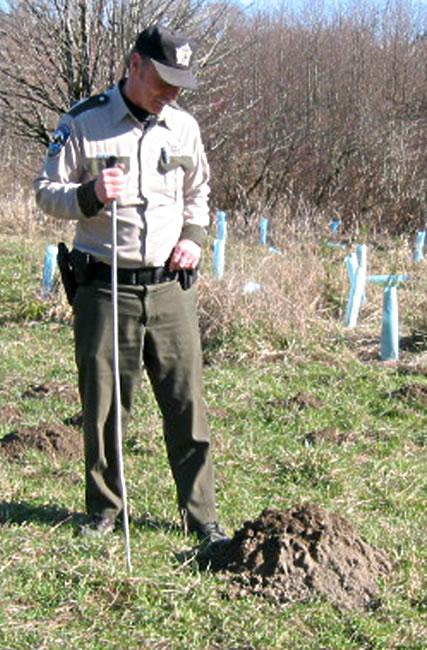
Though moles are the bane of many lawn owners, they make a significant positive contribution to the health of the landscape. Their extensive tunneling and mound building mixes soil nutrients and improves soil aeration and drainage. Moles also eat many lawn and garden pests, including cranefly larvae and slugs.
Moles spend almost their entire lives underground and have much in common with pocket gophers—small weak eyes, small hips for turning around in tight places, and velvety fur that is reversible to make backing up easy.
Moles also have broad front feet, the toes of which terminate in their characteristic stout claws faced outward for digging. (The Chehalis Indian word for mole translates into "hands turned backward.")
Facts about Washington moles
Territory
- Except during the breeding season and for a female mole with her young, moles are solitary animals that live in established burrow systems with limited overlap into other moles' territories.
- Typically, the ranges of neighboring male moles do not overlap, but each male's range may overlap those of a number of females, and female ranges may overlap with those of other females.
- Population densities vary from one adult mole in 6 acres to more than five adult moles per acre.
- The average city lot will rarely harbor more than one male or two female moles.
Food and Feeding Habits
- Although most North American moles are insectivorous, Washington species are somewhat omnivorous, eating both plants and animals.
- A mole's diet is mostly insects and other invertebrates, including earthworms, centipedes, millipedes, snails, slugs, grubs, ants, sowbugs, termites, beetles, and crickets (Fig. 2).
- Stomach samples in Oregon revealed that 70 to 90 percent of the Townsend mole's diet is earthworms; however it also ate grass roots, vegetable crop roots and bulbs, and seeds.
- Moles patrol their complex arrangement of tunnels in search of prey that use or fall into the tunnels.

Nest Sites and Reproduction
- Depending on the species and elevation, mating can take place from winter to early summer, producing a single litter of three to five young.
- The nest is constructed from soft vegetation that is matted down and interwoven to form a compact, protective shell about 2 inches thick. The nest is located within a cavity 5 to 18 inches underground, usually in "high ground" to prevent the nest from being flooded by late-winter or early spring rains.
- Green vegetation may be added to the nest after the young are born. As the wet plant material decays, it generates heat that is retained in the nest cavity, keeping the young warm when their mother is absent.
- Young moles disperse above ground at night during the month after weaning, forming their own territories within about 30 yards of their birth site.
- Moles reach sexual maturity at about ten months of age and breed in their first winter.
Mortality and Longevity
- Moles may come to the surface at night to search for food, nesting material, and new territories. Moles move slowly on the surface and are preyed upon by owls, hawks, and snakes.
- Because of their secluded life underground and their strong, musky odor, moles are unpalatable to most mammalian predators; however, raccoons and coyotes do dig them out, presumably to eat them.
- Moles are also killed by domestic dogs and cats, but are rarely eaten.
- Spring floods kill many moles, especially young ones; humans also kill many moles.
- The maximum life span of moles ranges from four to six years.
Common moles of Washington
At a total length of 8 to 9 inches, the slate black Townsend mole (Scapanus townsendii) (Fig. 1), is the largest mole species in North America. It occurs in meadows, fields, pastures, lawns, and golf courses west of the Cascade mountains.
The Pacific mole (Scapanus orarius), also known as the coast mole, is similar in appearance to the Townsend mole, and ranges from 6 to 7 inches in total length. It inhabits drier, brushier, and more wooded habitats than the Townsend mole, including interior sagebrush areas.
At a total length of 4 to 5 inches, the gray to black Shrew-mole (Neurotrichus gibbsii) is the smallest mole in North America and is unique to the Pacific Northwest. These tiny moles have many shrew-like features—they lack the mole's developed forelegs for digging—and are found in shady ravines and along stream banks. Unlike other moles, which create characteristic molehills, shrewmoles do not create mole-hills and are commonly active above ground.
Viewing moles
Moles are active all year round at any time of day, but are rarely seen due to their underground existence. They are best recognized by their molehills, which they push up along their tunnel systems. Both moles and pocket gophers construct tunnels and mounds, but there are distinct differences (see Table 1 for comparisons).
Landscaped areas, which provide a perfect food source for moles, are often where you see their telltale signs. The soil is kept rich with heavy applications of organic materials such as mulch, compost, and manure. The soil is kept moist through watering or irrigation, and the presence of man-made borders, edgings, and timber or stonewalls. All of these provide the perfect environment for worms and soil insects.
A mole's territory is a mazelike system of connecting, intertwining underground tunnels located at various depths (Fig. 3). It's a perfect fortress in which to survive threats, either natural or manmade—drought, freezes, predators, toxic gases, and other poisons. They routinely scent-mark their tunnels while patrolling for insects and other invertebrates that travel or fall into their tunnel systems.

Moles construct two kinds of tunnels: surface tunnels and deep tunnels, or runways. Surface tunnels are located 1 to 4 inches below the surface. These appear as 3-inch wide ridges or rips in the lawn or in soil, or as puffed-up areas in mulch. In lawns, surface tunnels are often held together only by the surrounding grass roots, and you may see the ridges—or feel them as you step on them. Surface tunnels wind around with no apparent direction or plan; they are used once or revisited several times for feeding purposes, and possibly for locating mates in the breeding season.
Surface tunnels connect with deeper runways that are located 3 to 12 inches below the surface, but may be as deep as 40 inches. Deep runways are main passageways that are used daily as the mole travels to and from surface tunnels and its nest.
Moles are fast diggers and can tunnel at a rate of 15 feet per hour. In favorable areas, shallow tunnels can be built at a rate of 12 inches per minute.
Digging is most pronounced in fall and winter when the soil is moist and easy for moles to work. In periods of dry weather or drought, moles tunnel deeper, near moist, cool areas where insects and worms congregate—along sewer drainfields and under sidewalks, rocky area, and shady fencerows.
Molehills
To create tunnels, the mole muscles its way through the soil with swimming motions, pushing the soil aside with alternating left and right paw strokes and compressing it against the tunnel walls. The large, thick, clawed forepaws do the digging, while the small hind feet provide leverage against the tunnel sides.
The soil excavated or cleaned out from the deep tunnels is pushed to the surface through vertical tunnels and forms the surface mounds, or molehills.
Molehills occur in the moist, loose earth found at the edges of woods and in fields, lawns, and other grasslands where food is available (Fig. 5). Excavated materials are piled in roughly circular mounds that are 6 to 24 inches in diameter and 2 to 8 inches high. The opening to the burrow is near the center of the mound and is always left plugged, but the plug often lacks definition.
Preventing Conflicts
Because of the surface tunnels and mounds they create, moles may be considered pests in yards, ball fields, golf courses, horse pastures, and other locations. Moles may also inadvertently heave small plants out of the ground as they tunnel, or damage plants when their mounds cover small seedlings. The easiest way to prevent minor plant damage is to regularly visit problem areas, taking a few moments to reposition or uncover plants as needed.
Moles, gophers, and voles (large mouse-like rodents which also occupy mole tunnels) can be found in the same location, and positive identification is needed, as control methods differ for each species. See the handouts on gophers and voles for information.
Moles are here to stay and extermination is impractical, especially if your property borders an area that has historically served as a source of moles. While you may be able to remove an existing mole population or drive moles elsewhere, if suitable conditions exist and moles occur nearby, other moles will eventually move into vacated areas. In addition, it is important to understand that mole problems rarely can be resolved by a quick fix method, but that a continuing commitment to whatever solutions are adopted is required.
To prevent conflicts or remedy existing problems, consider the following:
Repellents: No repellents currently available will reliably protect lawns or other plantings from moles. However, people mistakenly think they have successfully repelled a mole because they don't see new molehills for long periods following use.
The reasons for this are simple: moles are relatively solitary animals except for when breeding and rearing young, and they have large, complex tunnel systems that may extend for several hundred lineal feet. Moles may work one portion of their tunnel system for a few days and then move on some distance away to another portion of the system, which may be in the neighbor's yard. Hence, the application of some obnoxious substance just prior to or immediately following the mole's shift in its feeding location will be credited to the effect of the repellent. When the mole returns a week or two later, the gardener is convinced it is a new mole.
Mothballs, garlic, or spearmint leaves placed in the tunnels, and a perimeter of mole plants (Euphorbia spp.) planted around gardens, have all produced mixed results. Similarly, ground or broken pieces of glass, used razor blades, sections of barbed wire, or thorned rose bush canes have all been placed in mole tunnels. Some of these are actually more hazardous to the gardeners themselves than to the moles.
When moles run into the unfamiliar foreign object in their tunnels, they may simply circumvent the object by blocking those tunnels off with soil and then proceed to dig new tunnels, just as they do with a poorly set trap. There is no convincing evidence that these sharp, potentially harmful items cause any mortality or that they have resulted in the mole leaving the immediate area.

Before trying to control moles, be sure that they are truly a problem. If the individual mole is not really a problem, consider it an asset.
To remove the visible presence of the mole's little-understood lifestyle, try the following:
Molehills (Fig 4): Remove them as they appear or before mowing by shoveling up the earth, scooping up the earth with your hands, or spreading it in place with a rake. Grass seed can be spread over large bare areas throughout the rainy months.
Surface ridges: Flatten these ridges with your foot.
Run depressions: Bring in sand or screened dirt to fill the depressions, and then reseed.
Passive acceptance: The subterranean life your wild neighbor leads beneath your feet is there for your understanding and enjoyment if you so choose.
To render mole activity less obvious, try adopting a more naturalistic landscape style and let the lawn grow up to hide mole activity. Cut grass with a weed-whacker to the desired height as required for a semi-tidy look. You can take advantage of the soil preparation done by moles by planting shrubs and other plant material directly into mole mounds. This process eventually transforms the lawn area into a wildlife-friendly landscape setting where mole activity goes unnoticed.
Scare tactics: Although numerous devices are commercially available to use to frighten moles (vibrating stakes, ultrasonic devices, pinwheels, etc.), moles do not frighten easily. This is probably because of their repeated exposure to noise and vibrations from sprinklers, people moving about, and lawnmowers and other power equipment. Consequently, frightening devices have not proven to be effective in Washington. Note: Be skeptical of commercial products and claims, and make sure the manufacturer offers a money-back guarantee if the product proves ineffective.
Food reduction: It is often suggested that if you eliminate grubs from an area you will get rid of moles. Grubs, however, make up only a portion of the mole's diet. During dry periods, moles are known to frequent well-irrigated lawns just for moisture. Thus, moles often are present even in grub-free yards. If all the earthworms, grubs, and other soil animals in a lawn are eliminated by repeated insecticide application, moles may be forced to seek other areas.
The use of soil insecticides is an expensive approach with no immediate reduction of damage and little likelihood of long-term control. In the process, soil insecticides may poison the groundwater, kill beneficial soil invertebrates, and damage songbirds and other desirable wildlife.
Barriers: Constructing an underground barrier to keep moles from tunneling into an area can be labor-intensive and costly; however, it is recommended for exceptional situations. See "Preventing Conflicts" section in Pocket Gophers for information and designs.
Natural control: A long-term way to help prevent conflicts with moles is natural control. Predators—including snakes, dogs, and coyotes—kill moles. In addition, attracting barn owls and other raptors, which prey on juvenile moles when they disperse, may help control a mole population, particularly in rural areas.
Predators alone won't always keep mole populations below the levels that cause conflicts in gardens and landscaped areas. However, when combined with other control techniques, including practicing tolerance, natural control can contribute to overall control
Lethal Control
Before using a lethal control, make sure it's moles, and not pocket gophers (especially a listed species—see "Legal Status" section in the the Pocket Gophers - Preventing Conflicts page) you are trying to control.
Because moles are territorial, removing them from an area may appear to solve the problem. However, other moles will eventually enter the area if attractive habitat is available. Long-term control is not often possible.
Moles can be controlled any time, but it is best to concentrate the effort in late winter and early spring, before they give birth.
Trapping: See Trapping Regulations
Poisoning and Stunning: Since moles feed on insects and worms, poisoned baits have proven to be ineffective on moles. A new gel-type bait has been registered for mole control, however, it has not been on the market long enough to determine its control value for Washington moles. If toxic mole bait is used, follow all label directions to prevent the possibility of poisoning non-target wildlife species, domestic animals, or humans.
Gas cartridges and smoke bombs are unreliable. Their effectiveness is probably compromised by the extensive nature of mole tunnel systems and because gas diffuses in soil. Moles will seal off their burrows in seconds when they detect smoke or gas.
If using gas cartridges, use them only on moles that have just invaded an area, as their burrow systems will be less extensive. Apply a cartridge into the main tunnel and not into the shallow feeding tunnels. A cartridge should be placed in two or more locations of what is believed to be the burrow system of one mole. Turning on the sprinkler to wet the soil surface of the garden or turf prior to the application will aid in retaining the toxic gas in the burrow system.
Because moles are sensitive to concussion, smacking a shovel on the ground above a mole in its surface tunnel often will quickly kill it.
Flooding: Moles can easily withstand normal garden or home landscape irrigation, but flooding can sometimes be used to force them from their burrows where they can be quickly dispatched with a shovel. The entire tunnel system will need to be quickly and completely flooded to evict its tenants. Five-gallon buckets of water poured in the hole will flood the area more quickly than a running hose.
Flooding has the greatest chance of succeeding if moles are invading the property for the first time. Where they are already well established, their systems are too extensive.
For best results and for humane reasons, concentrate the effort in late winter and early spring, before moles give birth. Be careful when attempting to flood out a mole near a building; doing so could damage the foundation or flood the basement or crawl space.
Shooting: Since moles spend most of their time underground, shooting is impractical unless you have the time and patience to wait for one to be active at or near the surface. For safety considerations, shooting is generally limited to rural situations and is considered too hazardous in more populated areas, even if legal.
Follow-up: Once moles have been controlled, monitor the area on a regular basis for signs of their return. If resident moles are trapped out, nearby moles often migrate into and use established tunnels. (Moles always take the path of least resistance, so taking over established mole tunnels fits that pattern.) To help monitor the area, level all existing mounds so fresh mounds can be easily seen.
Public Health Concerns
Diseases or parasites associated with moles are rarely a risk to humans or domestic animals.
Cats that are allowed to hunt outside may bring dead, uneaten moles inside the home. Dispose of these by placing a plastic bag over your hand, picking up the dead mole, turning the bag inside out while holding the animal, sealing the bag, and discarding it with the garbage. Using a plastic bag in this manner reduces the potential for flea, tick, or disease transmission.
Legal Status
Moles are unclassified and people may trap or kill moles on their own property when they are causing damage to crops, domestic animals, or their property (RCW 77.36.030). With the passing of Initiative 713, given their body-gripping design, traditionally used mole traps are no longer legal for use in Washington (RCW 77.15.192, 77.15.194; WAC 220-417-040). There are no exceptions for emergencies and no provisions that allow WDFW to issue verbal approval or special permits.
Additional Information
Books
Hygnstrom, Scott E., et al. Prevention and Control of Wildlife Damage. Lincoln, NE: University of Nebraska-Lincoln, Institute of Agriculture and Natural Resources, 1994. (Available from: University of Nebraska Cooperative Extension, 202 Natural Resources Hall, Lincoln, NE 68583-0819; phone: 402-472-2188; also see Internet Sites below.)
Maser, Chris. Mammals of the Pacific Northwest: From the Coast to the High Cascades. Corvalis: Oregon State University Press, 1998.
Nagorsen, David W. Royal British Columbia Museum Handbook: Opossums, Shrews, and Moles of British Columbia. Vancouver, BC: University of British Columbia Press, 1996.
Verts, B. J., and Leslie N. Carraway. Land Mammals of Oregon. Los Angeles: University of California Press, 1998.
Internet Resources